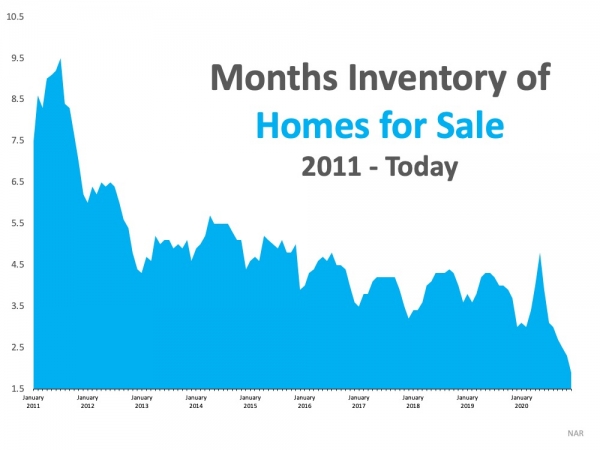What Record-Low Housing Inventory Means for You

The real estate market is expected to do very well in 2021, with mortgage rates that are hovering at historic lows and forecasted by experts to remain favorable throughout the year. One challenge to the housing industry, however, is the lack of homes available for sale today. Last week, the National Association of Realtors (NAR) released their Existing Home Sales Report, which shows that the inventory of homes for sale is currently at an all-time low. The report explains:
“Total housing inventory at the end of December totaled 1.07 million units, down 16.4% from November and down 23% from one year ago (1.39 million). Unsold inventory sits at an all-time low 1.9-month supply at the current sales pace, down from 2.3 months in November and down from the 3.0-month figure recorded in December 2019. NAR first began tracking the single-family home supply in 1982.”
(See graph below):
What Does This Mean for You?
If You’re a Buyer:
Be patient during your home search. It may take time to find a home you love. Once you do, however, be ready to move forward quickly. Get pre-approved for a mortgage, be prepared to make a competitive offer from the start, and know that a shortage in inventory could mean you’ll enter a bidding war. Calculate just how far you’re willing to go to secure a home and lean on your real estate professional as an expert guide along the way. The good news is, more inventory is likely headed to the market soon, Lawrence Yun, Chief Economist at NAR, notes:
“To their credit, homebuilders and construction companies have increased efforts to build, with housing starts hitting an annual rate of near 1.7 million in December, with more focus on single-family homes…However, it will take vigorous new home construction in 2021 and in 2022 to adequately furnish the market to properly meet the demand.”
If You’re a Seller:
Realize that, in some ways, you’re in the driver’s seat. When there’s a shortage of an item at the same time there’s a strong demand for it, the seller is in a good position to negotiate the best possible terms. Whether it’s the price, moving date, possible repairs, or anything else, you’ll be able to request more from a potential purchaser at a time like this – especially if you have multiple interested buyers. Don’t be unreasonable, but understand you probably have the upper hand.
Bottom Line
The housing market will remain strong throughout 2021. Know what that means for you, whether you’re buying, selling, or doing both.
Home Maintenance Projects To Tackle This Winter
Biden’s Actions on Fair Housing
January 29, 2021 By: Sehar Siddiqi
President Biden recently issued several actions related to ending discrimination and promoting fair housing and equal opportunity for all Americans. Included in these was the January 20,2021, Executive Order on Preventing and Combating Discrimination on the Basis of Gender Identity or Sexual Orientation and the January 26, 2021, Memorandum on Redressing Our Nation’s and the Federal Government’s History of Discriminatory Housing Practices and Policies.
Executive Order on Preventing and Combating Discrimination on the Basis of Gender Identity or Sexual Orientation
The executive order directs heads of federal agencies to examine previous agency actions and promulgate new actions to ensure that statutes prohibiting sex discrimination, including the Fair Housing Act, are implemented consistent with the Supreme Court’s 2020 holding in Bostock v. Clayton County.
In Bostock, the Supreme Court held that the prohibition on discrimination “because of sex” in Title VII of the Civil Rights Act of 1964 encompasses discrimination based on sexual orientation and gender identity.
The order directs federal agencies to interpret all civil rights laws, including the Fair Housing Act, that include a prohibition on discrimination “because of sex” to include discrimination on the basis of sexual orientation and gender identity.
NAR supports including sexual orientation and gender identity as protected classes under the Fair Housing Act, having amended the NAR code of ethics to prohibit discrimination in real estate based on sexual orientation in 2010 and gender identity in 2013. NAR adopted policy in 2016 to support legislation that includes sexual orientation and gender identity as prohibited bases for discrimination under the Fair Housing Act.
Memorandum on Redressing Our Nation’s and the Federal Government’s History of Discriminatory Housing Practices and Policies
The memorandum directs the federal government to redress its history of discriminatory housing and lending practices by actively combatting racial bias in rental and home-purchase transactions, eliminating barriers to housing choice, and supporting the development of safe, inclusive communities.
The memorandum specifically calls on the Department of Housing and Urban Development (HUD) to examine the Trump Administration’s repeal of the Affirmatively Furthering Fair Housing rule and the 2020 rule amending HUD’s interpretation of the Fair Housing Act’s disparate impact standard to determine if those actions had a detrimental impact on HUD’s duty to uphold the Fair Housing Act. Following that review, HUD is directed to ensure its programs and procedures are affirmatively furthering fair housing and fully enforcing the Fair Housing Act, including the prevention of practices with an unjustified discriminatory effect.
In 2020 NAR sent a comment letter asking for HUD to withdraw the rule to amend the interpretation of the Fair Housing Act’s disparate impact standard. NAR also sent comment stating its support of the Affirmatively Furthering Fair Housing requirement in the Fair Housing Act.
Executive Order on Preventing and Combating Discrimination on the Basis of Gender Identity or Sexual Orientation
JANUARY 20, 2021
By the authority vested in me as President by the Constitution and the laws of the United States of America, it is hereby ordered as follows:
Section 1. Policy. Every person should be treated with respect and dignity and should be able to live without fear, no matter who they are or whom they love. Children should be able to learn without worrying about whether they will be denied access to the restroom, the locker room, or school sports. Adults should be able to earn a living and pursue a vocation knowing that they will not be fired, demoted, or mistreated because of whom they go home to or because how they dress does not conform to sex-based stereotypes. People should be able to access healthcare and secure a roof over their heads without being subjected to sex discrimination. All persons should receive equal treatment under the law, no matter their gender identity or sexual orientation.
These principles are reflected in the Constitution, which promises equal protection of the laws. These principles are also enshrined in our Nation’s anti-discrimination laws, among them Title VII of the Civil Rights Act of 1964, as amended (42 U.S.C. 2000e et seq.). In Bostock v. Clayton County, 590 U.S. ___ (2020), the Supreme Court held that Title VII’s prohibition on discrimination “because of . . . sex” covers discrimination on the basis of gender identity and sexual orientation. Under Bostock‘s reasoning, laws that prohibit sex discrimination — including Title IX of the Education Amendments of 1972, as amended (20 U.S.C. 1681 et seq.), the Fair Housing Act, as amended (42 U.S.C. 3601 et seq.), and section 412 of the Immigration and Nationality Act, as amended (8 U.S.C. 1522), along with their respective implementing regulations — prohibit discrimination on the basis of gender identity or sexual orientation, so long as the laws do not contain sufficient indications to the contrary.
Discrimination on the basis of gender identity or sexual orientation manifests differently for different individuals, and it often overlaps with other forms of prohibited discrimination, including discrimination on the basis of race or disability. For example, transgender Black Americans face unconscionably high levels of workplace discrimination, homelessness, and violence, including fatal violence.
It is the policy of my Administration to prevent and combat discrimination on the basis of gender identity or sexual orientation, and to fully enforce Title VII and other laws that prohibit discrimination on the basis of gender identity or sexual orientation. It is also the policy of my Administration to address overlapping forms of discrimination.
Sec. 2. Enforcing Prohibitions on Sex Discrimination on the Basis of Gender Identity or Sexual Orientation. (a) The head of each agency shall, as soon as practicable and in consultation with the Attorney General, as appropriate, review all existing orders, regulations, guidance documents, policies, programs, or other agency actions (“agency actions”) that:
(i) were promulgated or are administered by the agency under Title VII or any other statute or regulation that prohibits sex discrimination, including any that relate to the agency’s own compliance with such statutes or regulations; and
(ii) are or may be inconsistent with the policy set forth in section 1 of this order.
(b) The head of each agency shall, as soon as practicable and as appropriate and consistent with applicable law, including the Administrative Procedure Act (5 U.S.C. 551 et seq.), consider whether to revise, suspend, or rescind such agency actions, or promulgate new agency actions, as necessary to fully implement statutes that prohibit sex discrimination and the policy set forth in section 1 of this order.
(c) The head of each agency shall, as soon as practicable, also consider whether there are additional actions that the agency should take to ensure that it is fully implementing the policy set forth in section 1 of this order. If an agency takes an action described in this subsection or subsection (b) of this section, it shall seek to ensure that it is accounting for, and taking appropriate steps to combat, overlapping forms of discrimination, such as discrimination on the basis of race or disability.
(d) Within 100 days of the date of this order, the head of each agency shall develop, in consultation with the Attorney General, as appropriate, a plan to carry out actions that the agency has identified pursuant to subsections (b) and (c) of this section, as appropriate and consistent with applicable law.
Sec. 3. Definition. “Agency” means any authority of the United States that is an “agency” under 44 U.S.C. 3502(1), other than those considered to be independent regulatory agencies, as defined in 44 U.S.C. 3502(5).
Sec. 4. General Provisions. (a) Nothing in this order shall be construed to impair or otherwise affect:
(i) the authority granted by law to an executive department or agency, or the head thereof; or
(ii) the functions of the Director of the Office of Management and Budget relating to budgetary, administrative, or legislative proposals.
(b) This order shall be implemented consistent with applicable law and subject to the availability of appropriations.
(c) This order is not intended to, and does not, create any right or benefit, substantive or procedural, enforceable at law or in equity by any party against the United States, its departments, agencies, or entities, its officers, employees, or agents, or any other person.
JOSEPH R. BIDEN JR.
THE WHITE HOUSE,
January 20, 2021.
Is Right Now the Right Time to Sell? [INFOGRAPHIC]
![Is Right Now the Right Time to Sell? [INFOGRAPHIC] | MyKCM](https://files.mykcm.com/2021/01/29150937/20210129-MEM-FINAL-1046x1262.png)
Some Highlights
- If you’re on the fence about selling your house, now is a great time to take advantage of sky-high demand, low supply, and fierce buyer competition.
- With buyer demand rising and historically low inventory for sale, if you’re in a position to move, your house may really stand out from the crowd.
- Let’s connect today to get your listing process underway.
What’s the Difference between an Appraisal and a Home Inspection?

A question that I get asked a lot is what the difference between an inspection and an appraisal is. They are actually similar because an appraiser looks at a lot of the same things. However, it’s who it’s for. An inspection is for your benefit. An appraisal is for the bank’s.
If you’re planning to buy a home, an appraisal is an important step in the process. It’s a professional evaluation of the market value of the home you’d like to buy. In most cases, an appraisal is ordered by the lender to confirm or verify the value of the home prior to lending a buyer money for the purchase. It’s also a different step in the process from a home inspection, which assesses the condition of the home before you finalize the transaction. Here’s the breakdown of each one and why they’re both important when buying a home.
Home Appraisal
The National Association of Realtors (NAR) explains:
“A home purchase is typically the largest investment someone will make. Protect yourself by getting your investment appraised! An appraiser will observe the property, analyze the data, and report their findings to their client. For the typical home purchase transaction, the lender usually orders the appraisal to assist in the lender’s decision to provide funds for a mortgage.”
When you apply for a mortgage, an unbiased appraisal (which is required by the lender) is the best way to confirm the value of the home based on the sale price. Regardless of what you’re willing to pay for a house, if you’ll be using a mortgage to fund your purchase, the appraisal will help make sure the bank doesn’t loan you more than what the home is worth.
This is especially critical in today’s sellers’ market where low inventory is driving an increase in bidding wars, which can push home prices upward. When sellers are in a strong position like this, they tend to believe they can set whatever price they want for their house under the assumption that competing buyers will be willing to pay more.
However, the lender will only allow the buyer to borrow based on the value of the home. This is what helps keep home prices in check. If there’s ever any confusion or discrepancy between the appraisal and the sale price, your trusted real estate professional will help you navigate any additional negotiations in the buying process.
Home Inspection
Here’s the key difference between an appraisal and an inspection. MSN explains:
“In simplest terms, a home appraisal determines the value of a home, while a home inspection determines the condition of a home.”
The home inspection is a way to determine the current state, safety, and condition of the home before you finalize the sale. If anything is questionable in the inspection process – like the age of the roof, the state of the HVAC system, or just about anything else – you as a buyer have the option to discuss and negotiate any potential issues or repairs with the seller before the transaction is final. Your real estate agent is a key expert to help you through this part of the process.
Bottom Line
The appraisal and the inspection are critical steps when buying a home, and you don’t need to manage them by yourself. Let’s connect today so you have the expert guidance you need to navigate through the entire homebuying process.
Signs You’re Ready To Buy A Home (That Have Nothing To Do With Your Bank Account)
Financial Fundamentals for Homebuyers [INFOGRAPHIC]
![Financial Fundamentals for Homebuyers [INFOGRAPHIC] | MyKCM](https://files.mykcm.com/2021/01/21112814/20210122-MEM-1046x2231.png)
Some Highlights
- When you’re thinking about buying a home, there are a few key steps to take before you even start to look at houses.
- From saving for your down payment to getting pre-approved for a mortgage, you’ll want to make sure you keep your financial plan on track from the beginning.
- Let’s connect today to make sure you have an introduction to a trusted lender and the best possible real estate guidance as you begin your homebuying process.
Here’s How To Brighten Up Your Winter Listing Photos
What Experts Are Saying about the 2021 Job Market

Earlier this month, the Bureau of Labor Statistics (BLS) released their most recent Jobs Report. The report revealed that the economy lost 140,000 jobs in December. That’s a devastating number and dramatically impacts those households that lost a source of income. However, we need to give it some context. Greg Ip, Chief Economics Commentator at the Wall Street Journal (WSJ), explains:
“The economy is probably not slipping back into recession. The drop was induced by new restrictions on activity as the pandemic raged out of control. Leisure and hospitality, which includes restaurants, hotels, and amusement parks, tumbled 498,000.”
In the same report, Michael Pearce, Senior U.S. Economist of Capital Economics, agreed:
“The 140,000 drop in non-farm payrolls was entirely due to a massive plunge in leisure and hospitality employment, as bars and restaurants across the country have been forced to close in response to the surge in coronavirus infections. With employment in most other sectors rising strongly, the economy appears to be carrying more momentum into 2021 than we had thought.”
Once the vaccine is distributed throughout the country and the pandemic is successfully under control, the vast majority of those 480,000 jobs will come back.
Here are two additional comments from other experts, also reported by the WSJ that day:
Nick Bunker, Head of Research in North America for Indeed:
“These numbers are distressing, but they are reflective of the time when coronavirus vaccines were not rolled out and federal fiscal policy was still deadlocked. Hopefully, the recent legislation can help build a bridge to a time when vaccines are fully rolled out and the labor market can sustainably heal.”
Michael Feroli, Chief U.S. Economist for JPMorgan Chase:
“The good news in today’s report is that outside the hopefully temporary hit to the food service industry, the rest of the labor market appears to be holding in despite the latest public health challenges.”
What impact will this have on the real estate market in 2021?
Some are concerned that with millions of Americans unemployed, we may see distressed properties (foreclosures and short sales) dominate the housing market once again. Rick Sharga, Executive Vice President at RealtyTrac, along with most other experts, doesn’t believe that will be the case:
“There are reasons to be cautiously optimistic despite massive unemployment levels and uncertainty about government policies under the new Administration. But while anything is possible, it’s highly unlikely that we’ll see another foreclosure tsunami or housing market crash.”
Bottom Line
For the households that lost a wage earner, these are extremely difficult times. Hopefully, the new stimulus package will lessen some of their pain. The health crisis, however, should vastly improve by mid-year with expectations that the jobs market will also progress significantly.

